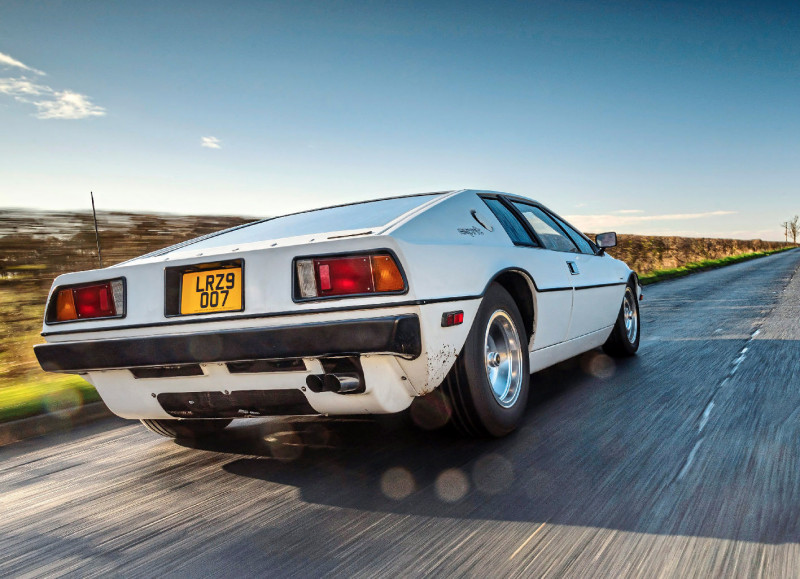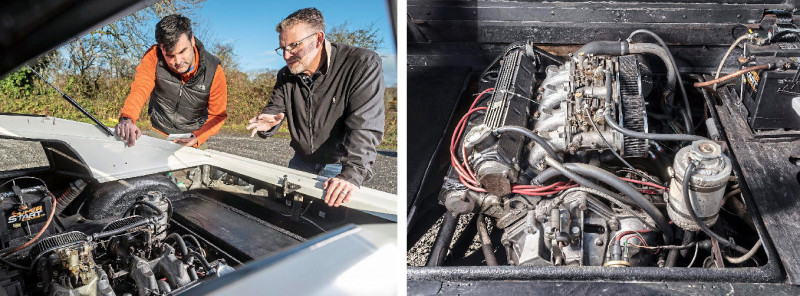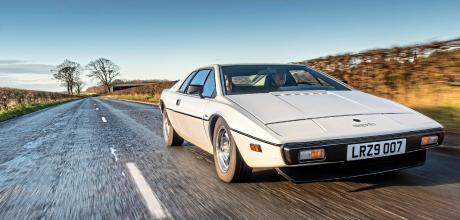1977 Lotus Esprit S1
Classic Cars reader Jon Ranwell has always fancied driving a Lotus Esprit ever since The Spy Who Loved Me was released. Will reality match celluloid dreams?
Words SAM DAWSON
Photography JONATHAN JACOB
‘It’s like driving a concept car’
The List Will Bond fan Jon Ranwell turn out to be the spy who loves the Lotus Esprit S1?
We help reader Jon Ranwell put his 007 Lotus Esprit fantasy to the test
I feel like I’ve done Classic Cars reader Jon Ranwell a bigger favour than usual in arranging his dream drive today. ‘I’m a huge James Bond fan, and last year for Christmas I was bought a “Drive a Bond car” Aston Martin DB5 experience-day voucher,’ says Jon, as we stand in a country-pub car park admiring Blackpool Tower from afar. ‘However, every time I’ve called the experience firm to try and set it up, every available date has been sold out. The voucher expires at the end of the month, and I thought that would be my chance to drive a Bond car gone. But then you called and offered me the chance to drive a Lotus Esprit S1!’

The List Your Dream Drive Made Real
We’ve been listening intently for the car’s arrival, the nearby B-road yielding nothing but the dull hiss of modern hatchbacks and the rattle of lorries. However, the rural Lancashire tranquility is suddenly punctured by a yowling, snorting twin-cam. A visually shocking wedge bursts from behind the hedgerows, double-declutching into the car park. It’s the Esprit, one of the purest, starkest examples of wedge design ever penned. And just like the most famous example – the one driven by Roger Moore in 1977’s The Spy Who Loved Me – this one’s white too. A broad grin spreads across Jon’s face.

‘I must admit, I did consider turning up wearing a tuxedo or a safari suit,’ says actor Jon – you may have seen him in Doctors, Midsomer Murders and any number of stage musicals. ‘But now I’m in its presence, I’m realising the first Esprit’s appeal goes so much deeper than Bond, and even Formula One. I first started watching F1 in the late Seventies, when Lotus was dominating everything with that incredible Type 78 ground-effect car, and at that time Colin Chapman had a gold Esprit which would be seen in the paddock sometimes. But what really grabs me is the sheer purity of its lines. There’s something about the very first versions of cars – they may not always be the fastest or most sorted, but they’re nearly always the best-looking, the closest to the designer’s original sketch.’

Jon clocks the tiny Styled By Giugiaro badge on the Esprit’s front wings as he paces around it, taking in its starkly dramatic lines. ‘Did Giorgetto Giugiaro work for Bertone?’ he muses. ‘Because I remember how it was with motor show concept cars in the Seventies – Bertone did angles, Pininfarina did curves, and Michelotti did Triumphs!’ Giugiaro did work for Bertone in the Sixties, and pioneered the wedge, although by the time the Esprit made its first appearance as the nameless ‘Silver Car’ at Geneva in 1972, he’d formed his own styling house, ItalDesign. Owner Lez McLair shows Jon the technique of boarding without catching his feet on the sill-mounted handbrake. He settles into the low-slung cockpit, unfazed by it being lhd – as most S1s were. ‘It feels like I’m about to drive a concept car,’ he remarks. ‘I must admit, I’m surprised by how comfy I am in here. Admittedly I can’t see the end of the bonnet, but there’s plenty of leg- and headroom – and I’m quite long in the back.
‘But I love how basic it seems in here, even alongside incredible concept-car shapes like this dashboard binnacle and the shagpile-carpeted bulkhead. The courtesy light switches in the door, for example, are just off-the-shelf items held against a simple steel plate. They’d be so easy to test, fit and replace, and yet they look like something hurriedly put together to get it ready for a show stand as an afterthought.
‘Then there are the controls – the pedals are heavily offset to clear the wheelarch, and the steering wheel is neither parallel with the instrument facia nor directly ahead of me. It’s as though the car’s underpinnings were designed separately, then tweaked to fit this amazing shape on top of them. And it’s got Morris Marina doorhandles! And yet alongside things like those, you have these lovely exotic-looking green Veglia dials, oblong speakers in the doors and a Seventies-futuristic typeface on the dashboard, all of which feel very bespoke. Again, it’s all very much done for a show stand, for a concept car. And how louche and Seventies is it to have ashtrays in the sills!’

Jon turns the ignition key, the Lotus twin-cam slant-four roars into life, and that grin reappears on his face. He gets the Esprit into gear, and takes it for a first foray onto the sinewy, damp tarmac of the Fylde, remaining quiet as he gets to grips with the car. ‘It takes a little getting used to,’ he ponders. ‘The bite point on the clutch, for example, but that’s normal for any unfamiliar car really. But what’s really surprising me is how, after ten minutes on the open road, it feels quite easy to drive. There’s nothing tricky about it, the gearchange is beautifully smooth, in fact the only really difficult thing about it is the visibility – it’s hard to judge where the nose of the car is, or see behind to reverse. But none of this matters, because I’m living a boyhood dream right now. It’s such an iconic car, and everyone knows it. I’ve only been driving it a short distance and it seems every single passing car has slowed down to get a better look at the Esprit. So much so that it must be frustrating waiting in it at a busy junction – as well as the visibility issues, you’ll have to deal with everyone stopping to stare at it.
‘But back to the way it drives – it’s not just the gearchange that’s smooth, it’s a very smooth car to drive all-round. I was bracing myself for something that felt a bit agricultural in places, but it isn’t. It’s relatively hard-riding – as in, suspension travel is limited – but it handles bumps and potholes well – those high tyre sidewalls around those gorgeous Wolfrace alloys must absorb them. I actually had a set of Wolfraces on a Mini I used to own, but they didn’t look as right as they do on this.’

Confidence built, Jon heads to a faster, more open road. ‘Time to stretch its legs a bit more,’ he says, opening the throttle, hearing the snarl from the exposed engine inches behind his head. ‘The more you drive it, the easier it gets,’ he notes. ‘The steering gets lighter, to the point where you can drive it onehanded, yet remains just as precise, the faster you go,’ he says as he aims the Esprit through a snaking series of S-bends. ‘In fact, given this combination of comfort, drivability and luggage space – there’s more than I expected behind the engine on that carpeted shelf, enough for a couple of suitcases so long as you didn’t mind them getting warm – I reckon it’d make for a great, very modern grand tourer. I want to drive it to the coast!’
I tell Jon that the Esprit S1 was criticised when new for being too noisy in its cabin for GT motoring, especially alongside rivals like the Maserati Merak. ‘You’re appreciating the sound of the engine though,’ Jon replies. ‘It’s audible, yes, but it’s a pleasant noise, and I can have a conversation in here. Before I drove it, I would have questioned its credibility as a daily-driver, but it’s far more usable than I was expecting. It also feels wellbuilt for its era and what it is. I know Lotus has this “lots of trouble, usually serious” reputation, but that probably stems from the kit era, when a lot of the car’s reliability was down to the person who built it, rather than fundamental design flaws. Although I don’t think I’d push it all the way to 7000rpm, as the dials and the original road tests suggested you could.
‘Another real surprise is the brakes. They’re really effective. Usually brakes are the weak part of a classic’s driving experience, resulting in alarmingly long stopping distances, but given that these discs don’t have much weight and mass to stop, they probably don’t need to be that powerful. It brakes like a much newer car. It’s so easy to engine-brake too. And the lack of castor in the steering makes it more pleasurable to corner. I know Lotus did away with traditional Ackerman angles with this era of cars, to keep the steering pure, and it works – you’re not fighting a self-centring action all the time. It goes exactly where you tell it to.
There’s no tramlining on rough surfaces either, which is impressive.’ Jon pulls the Esprit up to give it a rest and spend some more time admiring it from outside. ‘Hang on, I’ve just realised, I haven’t popped the headlights up yet!’ he says, with overt childlike glee. ‘It’s something I really miss about my old Triumph TR7 and Ford Probe, and it’s one of the sad losses from the automotive world. I know there are good reasons why we don’t have pop-up headlights any more – aerodynamics, safety – but, well, they’re just fun, aren’t they? It feels flamboyant to have things moving on the outside of a car. I often wonder whether, if all the rules were dropped in F1, constructors would end up building cars with lots of hinged planes and wings, and there would be things popping up and down on them as they went round the circuit, not just the rear wing’s downforce reduction system. As such, pop-up headlights feel like part of a future we never quite got.’ We walk around to the rear of the Esprit to get a better look at the engine. ‘It’s even more mid-engined than you think when you see it like that,’ says Jon. ‘It’s so far forward in the bay, so low, and balanced with a fuel tank each side for perfect weight distribution. Actually, it’s a very marine-feeling car. The use of glassfibre, the rubbing strip around the car that actually looks great, accentuating the lines while hiding the join of the bodyshell’s two main mouldings, and the engine bay itself looks like that of a Seventies speedboat. I can see why they used one as a submarine in The Spy Who Loved Me.’ It’s a perceptive point – Chapman bought into the aptly-named Moonraker Boats to access marine technology to shape this era of Lotuses, and in return Lotus designed some yachts and speedboats.
But has the car been as exciting as it looked on those Sardinian coast roads on the big screen in 1977? ‘It’s definitely still in my top ten – in fact it’s moved up the charts now,’ says Jon. ‘The way it looks has got even more striking after all these years, and it’s that which really impresses me. I think it helps that, unlike the Porsche Speedster, Cobra, Countach, Stratos and so on, no one’s ever done a kit-car replica. When you see an Esprit, you know it’s the real thing. And like all icons, everyone immediately knows what it is. It stands out even among modern supercars. It’s everything I wanted it to be, and of course it has that Bond connection. We’re still in awe of something 45 years old, still staring at it. It’s like Concorde was – you’d seen it hundreds of times, yet whenever one went over, everyone always looked up. ‘Could I see myself owning one? Definitely. Sadly it’s beyond my budget. But I have a ticket for tonight’s lottery…’
Jon likens the S1 to a speedboat, and not just for its bigscreen connotations
TECHNICAL DATA 1977 Lotus Esprit S1
- Engine 1973cc four-cyl, dohc, two Dell’Orto DHLA45D carbs
- Max power 160bhp @ 6200rpm
- Max torque 140lb ft @ 4900rpm
- Transmission Five-speed manual, rear-wheel drive
- Steering Rack and pinion
- Suspension Front: independent, double wishbones, coil springs, telescopic dampers, anti-roll bar. Rear: independent, semi-trailing arms, cross-links, fixed-length driveshafts, coil springs, telescopic dampers
- Brakes Servo discs front and rear
- Performance Top speed: 124mph;
- 0-60mph: 8.4sec
- Weight 1033kg
- Fuel cons. 25mpg
- Cost new £7979 CC
- Price Guide £28k-£40k
Jon’s not bothered by the vocality of the straight-four…… whose pair of Dell’Orto carbs sit inches from the bulkhead
‘I was bracing myself for something that felt a bit agricultural, but it isn’t’
Jon is delighted by the odd mix of bespoke and parts-bin fittings
It’s a cosy fit, but ‘long-in-the-back’ Jon insists he’s comfortable Pop-up headlights ‘part a future we never quite got’
‘What really grabs me is the sheer purity of its lines’


